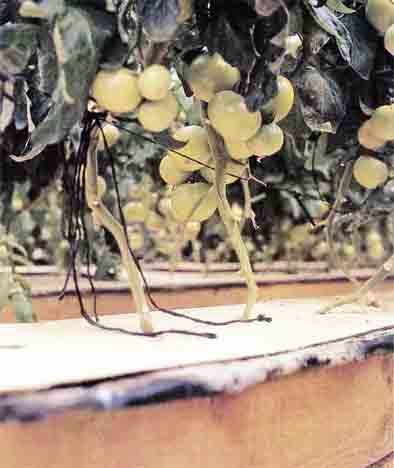
Decaying plant matter by adding humus to soil also improves its condition . Even in the most deficient soils some plant species are bound to become established paving the way for other species which may succeed them later.
Complex plant communities often develop, the New Zealand native forests for example, feeding large amounts of humus into the soil as old growth breaks down making way for new growth. The complex root systems of the native trees hold this enriched soil in place while the dense cover provided by their leaves keeps it moist and damp providing the ideal conditions for ferns and other undergrowth.
Plants when left alone adapt to, and modify, their environment very efficiently, the problems arise when humans trying to support large numbers of people, set up specialised monocultures. Single crop types are grown over large areas, requiring the use of large scale pesticide applications to eliminate competitors and other chemicals to reduce disease. The humus remaining in the soil from bygone native forests is soon expended requiring continued large scale applications of fertilisers which may provide plants with the nutrients they require but do not replace the function of humus in keeping the soil in a light, aerated, workable condition.
The home gardener is placed in a similar position on a new section which has had all but the minimum amount of topsoil, required to grow a layer of grass, removed during the subdivision process. Topsoil (and compost) has to be brought back to establish a vegetable garden or fruit trees. Fertilisers are needed as well as compost to bring up the humic content in the soil. The home gardener is further disadvantaged in not having technical advice available from the specialists who are often employed to analyse the soil conditions where large scale cropping is being undertaken and prescribe the fertiliser applications required. For the home gardener wanting to grow a range of crops, prevention is better than cure, the solution being to keep feeding a steady supply of fertiliser and compost into the vegetable garden soil rather than waiting for the deficiency symptoms described earlier to appear.
Hydroponic growing eliminates the problems associated with poor soil and it’s nutrient deficiencies for both the commercial and home grower. Rather than having to expend large quantities of fertilisers on a large area of soil where crops are to be grown, the commercial grower can instead cycle the required amounts within a compact hydroponic system adding more nutrients only as required.
Hydroponic systems eliminate the problems home gardeners come across when a fertiliser applied to one group of plants counteracts another fertiliser applied to different plants growing nearby. It is also easy to apply a nutrient to your plants in too large a quantity. Some of the important elements only need to be present in small amounts as they become toxic to plants if they are present in too high a concentration. A good hydroponic nutrient food, tailor made to the crop being grown, contains the right nutrients in the right proportions for optimum growth and is easily measured and adjusted with cheap, efficient and readily available equipment.

Plants growing outdoors and in their wild state will produce flowers and seeds efficiently to ensure that new generations of plants follow them. In a greenhouse you may have to pollinate plants yourself as the wind and bees, two of the natural agents aiding pollination, may not be present.

These tomatoes are being grown in plastic (polythene) lined wooden gullies which have a thin film of nutrient flowing through them (NFT).